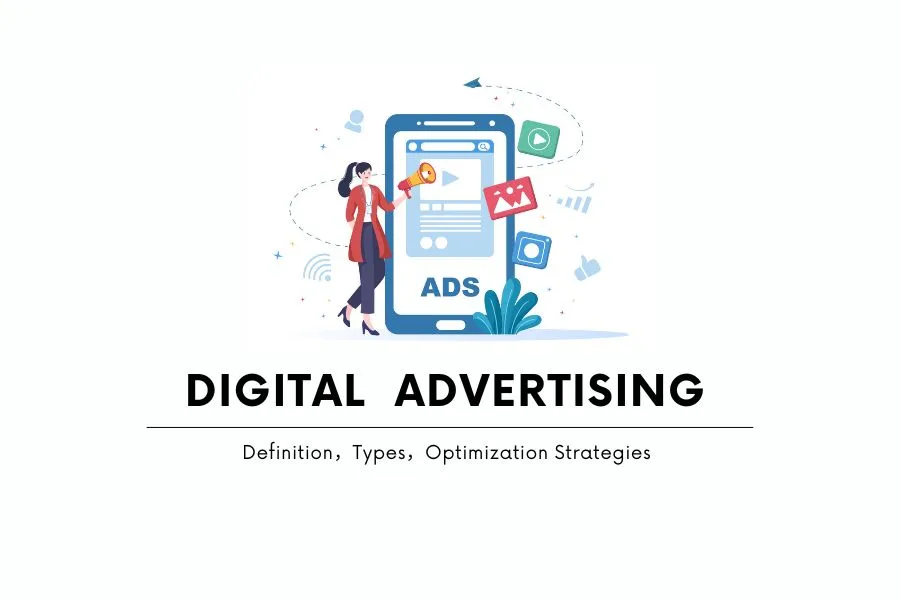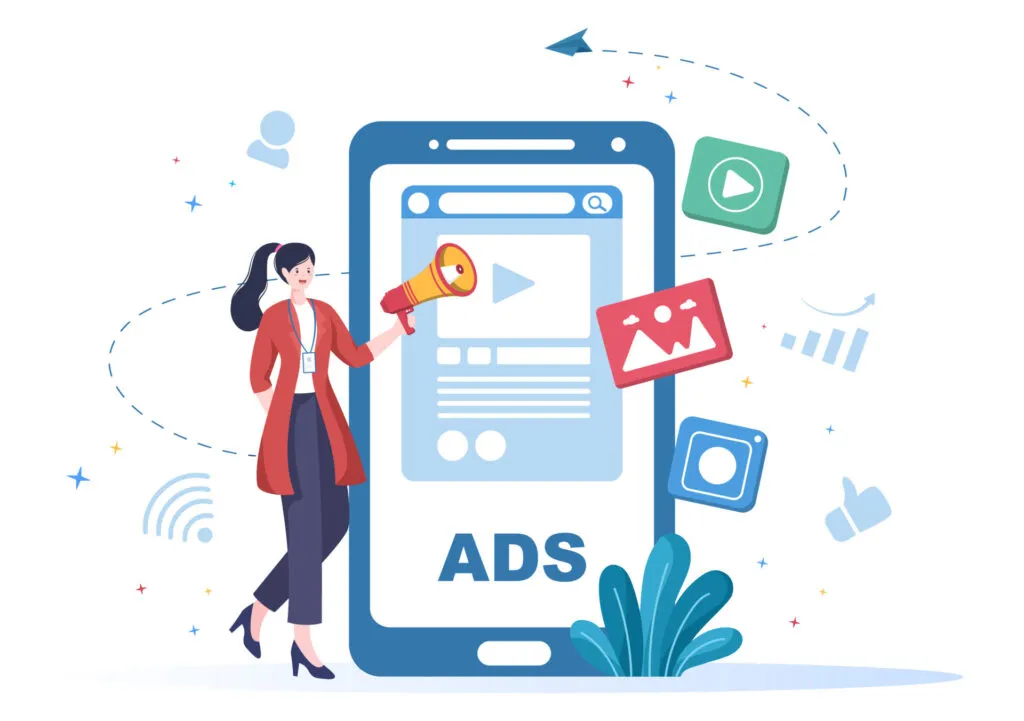
What is Digital Advertising?
Digital advertising, also known as online advertising or Internet advertising, is a form of advertising that promotes products, services, or brands through the Internet. It utilizes digital technology to deliver advertising messages to target audiences via various online platforms and devices, such as websites, social media, mobile applications, search engines, emails, etc.
Compared to traditional advertising, digital advertising offers a broader reach, more precise targeting capabilities, and more efficient ways to evaluate effectiveness.
Application Scenarios
- Brand Promotion: Enhance brand awareness and image.
- Product Promotion: Advertise new products or promotional activities to drive sales.
- Content Marketing: Attract and retain users by providing valuable content.
- Customer Acquisition and Conversion: Attract potential customers and employ various methods to convert them into actual customers.
What are the Advantages of Digital Advertising?
For businesses seeking cost-effectiveness, flexibility, and precision, digital advertising offers several advantages over traditional advertising, making it an increasingly popular choice in modern marketing.
Precise Targeting
By analyzing user data and behavior, digital advertising can accurately target specific audiences, increasing the relevance and effectiveness of ads.
High Interactivity
Unlike TV or print ads, digital ads allow users to interact with the content, such as clicking links, watching videos, participating in surveys, etc., enhancing user engagement.
Measurability
The effectiveness of ads can be monitored in real-time, and dynamic optimization can be performed based on the data to improve return on investment (ROI).
Cost-Effectiveness
Compared to traditional advertising, digital advertising typically offers higher cost-effectiveness because it can more precisely reach target users, reducing waste.
Diverse Ad Formats
Digital advertising comes in various forms, including but not limited to display ads, search engine marketing (SEM), social media ads, email marketing, and native ads. This diversity can meet different marketing needs and strategies, from brand promotion to direct sales conversion.
Flexibility
Ad content can be quickly updated or adjusted as needed to respond to market changes or to optimize ad performance.
What Types of Digital Advertising Are There?
Digital advertising encompasses various types, each with its unique features and application scenarios. Here are some common types of digital advertising and their detailed descriptions:
Search Engine Marketing (SEM)
Search Engine Marketing (SEM) is an internet marketing strategy that enhances website visibility and drives traffic by placing ads on search engine results pages (SERPs).

Types
Paid Search Ads: This is a paid advertising model where advertisers purchase keywords to display ads on the SERPs. Ads typically appear at the top or bottom of the search results page when users search for specific keywords. Advertisers bid on keywords. Google AdWords (now known as Google Ads) is one of the most famous PPC platforms.
Search Engine Optimization (SEO): This involves optimizing website content and structure to improve its ranking in organic search results, thereby attracting more organic traffic. It includes keyword research, content optimization, link building, and site architecture optimization.
Key elements of SEM
- Keyword Strategy: Identify search terms that target users might use and optimize the website and ads around these keywords.
- Ad Copy: Create compelling ad copy to increase click-through rates (CTR) and conversion rates.
- Budget Management: Allocate ad budgets effectively to maximize return on investment (ROI).
- Analysis and Optimization: Use analytics tools (like Google Analytics) to track ad performance and optimize based on data.
Display Advertising
Display Advertising involves visually-driven ads (such as images, videos, animations, text, etc.) shown on various websites and applications. They usually appear in sidebars, headers, or footers of web pages. Display ads are mainly distributed through ad networks like Google Display Network, aiming to increase brand awareness, attract traffic, and promote conversions and sales.

Types
Banner Ads: The most common form of display ads, typically placed at the top, bottom, or sidebar of a webpage. Banner ad sizes vary, with common ones being 728x90 and 300x250.
Interstitial Ads: Full-screen ads are shown during page loads or transitions, often covering the entire screen.
Video Ads: Ads in video format, usually embedded in video websites or social media platforms, offering a vivid way to convey messages and enhance user engagement.
Rich Media Ads: Ads with interactive elements such as animations, sliders, and click-to-expand features, allowing user interaction and increasing ad attractiveness and effectiveness.
Native Ads: Ads designed to match the content and style of the website or app, blending seamlessly with the content to reduce user disruption and increase acceptance.
Key elements of Display Advertising
- Creative Design: Eye-catching elements, including images, videos, animations, color schemes, and layout design, need to highlight the brand features and advertising message.
- Ad Copy: Clear and concise text conveying the core message and promotional offers, encouraging users to click. The copy should complement the visual elements to enhance appeal.
- Landing Page: The page users are directed to after clicking an ad. It should be relevant to the ad content, providing detailed information or promotional activities, optimizing user experience, and prompting further conversion.
Social Media Advertising
Social Media Advertising leverages ad tools and data on social media platforms (like Facebook, Instagram, X(twitter), LinkedIn, Snapchat, Pinterest, TikTok) to promote brands, products, or services. These ads can be targeted based on users’ social behavior, interests, and social networks.

Types
Image Ads: Straightforward ads using a single image to convey brand or product information, suitable for quickly delivering key messages.
Video Ads: Short videos showcasing brand stories, product features, or customer testimonials, with strong appeal and impact.
Carousel Ads: Ads displaying multiple images or videos in a single ad, allowing users to swipe through, suitable for showcasing multiple products or features.
Stories Ads: Full-screen vertical format ads inserted between user-viewed stories, offering high immersion and interactivity.
Interactive Ads: Ads with interactive elements like polls, quizzes, and filters, encouraging user participation and increasing engagement.
Dynamic Ads: Automatically generated personalized ads based on users’ browsing and shopping behaviors, suitable for e-commerce and retargeting campaigns.
Key elements of Social Media Advertising
- Target Audience Segmentation: Achieve precise targeting using platform-provided user data (age, gender, location, interests, behavior, etc.), ensuring ads reach the most relevant audience.
- Creative Design: Visually appealing and informative elements including images, videos, animations, and text that encourage clicks and interaction.
- Ad Placement Strategy: Determine ad placement time, frequency, and budget, optimizing according to user activity patterns and ad goals.
- Interaction and Engagement: Design ad content to consider user interaction methods like likes, comments, shares, and follows, enhancing user engagement and brand stickiness.
Mobile Advertising
Mobile Advertising involves displaying and placing ads on mobile devices (such as smartphones and tablets). This includes in-app ads, SMS ads, and mobile web ads.

Common platforms
- Mobile Apps: Ads are shown within apps like games or news readers.
- Mobile Web: Ads displayed on websites accessed via mobile browsers.
- Social Media Apps: Ads displayed within social media apps like Facebook, and Instagram.
Email Marketing
Email Marketing involves sending commercial messages to target audiences via email, including newsletters, promotional campaigns, product updates, etc. These emails can be personalized to increase open rates and click-through rates.

Types
Newsletters: Regular emails to subscribers containing company news, industry updates, and product updates, aimed at maintaining brand exposure and user stickiness.
Promotional Emails: Emails with a focus on the promotion, including discount information, special offers, and limited-time deals, aimed at driving sales and conversions.
Transactional Emails: Automatically triggered emails after specific user actions, such as order confirmations, shipping notifications, password resets, and providing important transaction information.
Welcome Emails: The first email received by users after subscribing or registering, containing welcome messages, company introductions, and initial offers, aimed at making a good first impression.
Retargeting Emails: Emails sent to users who have not completed a purchase or have been inactive for a while, including cart reminders, personalized recommendations, and re-engagement activities, aimed at re-attracting user attention.
Anniversary Emails: Emails marking special occasions like user registration anniversaries, and birthdays, typically containing greetings and special offers, aimed at enhancing emotional connection with users.
Digital Advertising Optimization Strategies
Optimizing digital advertising is an ongoing process aimed at improving ad performance, reducing costs, and enhancing return on investment (ROI). The optimization involves various strategies. Here are some detailed optimization strategies and methods:

Ad Creative Optimization
Visual Design
- High-Quality Images and Videos: Use clear, professional images and videos to ensure visually appealing effects.
- Consistent Brand Image: Maintain brand consistency, including colors, fonts, and logos.
- Responsive Design: Ensure ads display well across different devices and screen sizes.
Ad Copy
- Concise and Powerful Headlines: The primary element to attract user attention is to convey the core message succinctly.
- Clear Call-to-Action (CTA): Use strong action words like "Buy Now," "Sign Up for Discounts," etc.
- Personalized Content: Customize ad copy based on the audience's interests and behaviors to make it more relevant.
Target Audience Segmentation
Market Segmentation
- Demographics: Segment the audience based on age, gender, income, occupation, etc.
- Geographic Location: Target specific regional markets for more tailored ad placement.
- Interests and Behaviors: Target based on users' interests, browsing history, and purchase behaviors.
Remarketing
- Website Visitor Remarketing: Show ads to users who have visited your website to increase conversion possibilities.
- Cart Abandonment Remarketing: Send reminder ads or promotional information to users who did not complete their purchase.
Lookalike Audiences
- Expand Potential Customers: Use existing customer data to find new audiences similar to them, expanding reach.
Data Analysis and Optimization
A/B Testing
- Test Different Creatives: Compare different ad creatives, copy, and CTAs to find the most effective combination.
- Test Placement Strategies: Compare different target audiences, ad times, and frequencies to optimize performance.
Real-Time Monitoring and Adjustment
- Track Key Metrics: Such as click-through rate (CTR), conversion rate, ROI, etc., to promptly identify issues and improvement opportunities.
- Dynamic Adjustment: Adjust budget allocation, targeting strategies, and ad creatives based on real-time data to ensure optimal results.
Attribution Analysis
- Multi-Channel Attribution: Analyze user behavior across different channels to understand the contribution of each touchpoint and optimize cross-channel ad strategies.
Budget Management Optimization
Smart Bidding
- Automated Bidding Tools: Use platform-provided automated bidding tools to adjust bids based on predefined goals (e.g., conversions, clicks).
- Budget Allocation: Adjust budgets flexibly based on ad performance for different ad campaigns, groups, and keywords.
Frequency Control
- Avoid Overexposure: Control ad frequency to avoid user fatigue from seeing the same ad too often.
- Reasonable Frequency Distribution: Allocate ad frequency reasonably among different audience segments and time slots.
Utilizing Advanced Technology
Programmatic Advertising
- Real-Time Bidding (RTB): Use programmatic ad platforms to improve ad placement efficiency and effectiveness through real-time bidding.
- Audience Segmentation: Utilize big data and machine learning for more detailed audience analysis and targeting.
Dynamic Creative Optimization (DCO)
- Personalized Ads: Automatically generate and display personalized ad content based on real-time user data, enhancing relevance and engagement.
User Experience Optimization
Landing Page Optimization
- Relevance: Ensure landing page content aligns with ad content, providing the information users expect.
- Load Speed: Optimize landing page load speed to reduce bounce rates.
- Simplify Conversion Process: Design a clear and straightforward conversion path, minimizing user steps to increase conversion rates.
User Feedback and Continuous Improvement
Collect User Feedback
- User Surveys: Gather user feedback and suggestions through surveys and feedback forms.
- Social Media Interaction: Monitor user comments and feedback on social media, respond promptly, and make necessary adjustments.
Continuous Learning and Improvement
- Industry Trends: Stay updated on developments and new technologies in the digital advertising industry to continuously refine ad strategies.
- Competitor Analysis: Analyze competitors' ad strategies to learn their strengths and identify areas for improvement.
By employing these strategies and methods to continuously optimize ad creatives, audience targeting, budget management, and user experience, you can significantly enhance the effectiveness of digital advertising, achieving higher ROI and brand value.














